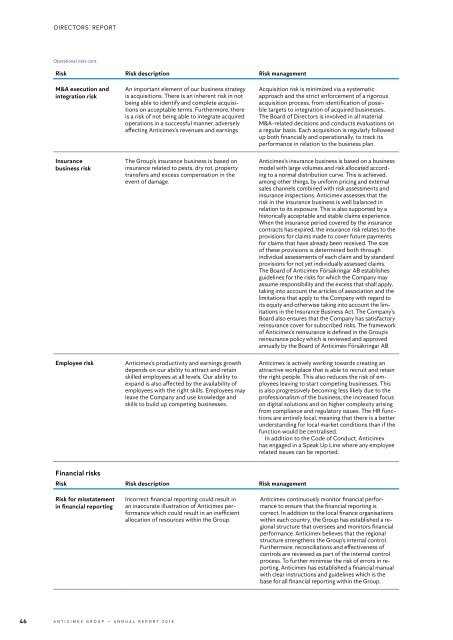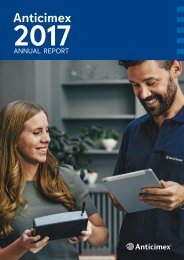Anticimex Annual Report 2018
You also want an ePaper? Increase the reach of your titles
YUMPU automatically turns print PDFs into web optimized ePapers that Google loves.
DIRECTORS’ REPORT<br />
Operational risks cont.<br />
Risk Risk description Risk management<br />
M&A execution and<br />
integration risk<br />
An important element of our business strategy<br />
is acquisitions. There is an inherent risk in not<br />
being able to identify and complete acquisitions<br />
on acceptable terms. Furthermore, there<br />
is a risk of not being able to integrate acquired<br />
operations in a successful manner, adversely<br />
affecting <strong>Anticimex</strong>’s revenues and earnings.<br />
Acquisition risk is minimized via a systematic<br />
approach and the strict enforcement of a rigorous<br />
acquisition process, from identification of possible<br />
targets to integration of acquired businesses.<br />
The Board of Directors is involved in all material<br />
M&A-related decisions and conducts evaluations on<br />
a regular basis. Each acquisition is regularly followed<br />
up both financially and operationally, to track its<br />
performance in relation to the business plan.<br />
Insurance<br />
business risk<br />
The Group’s insurance business is based on<br />
insurance related to pests, dry rot, property<br />
transfers and excess compensation in the<br />
event of damage.<br />
<strong>Anticimex</strong>’s insurance business is based on a business<br />
model with large volumes and risk allocated according<br />
to a normal distribution curve. This is achieved,<br />
among other things, by uniform pricing and external<br />
sales channels combined with risk assessments and<br />
insurance inspections. <strong>Anticimex</strong> assesses that the<br />
risk in the insurance business is well balanced in<br />
relation to its exposure. This is also supported by a<br />
historically acceptable and stable claims experience.<br />
When the insurance period covered by the insurance<br />
contracts has expired, the insurance risk relates to the<br />
provisions for claims made to cover future payments<br />
for claims that have already been received. The size<br />
of these provisions is determined both through<br />
individual assessments of each claim and by standard<br />
provisions for not yet individually assessed claims.<br />
The Board of <strong>Anticimex</strong> Försäkringar AB establishes<br />
guidelines for the risks for which the Company may<br />
assume responsibility and the excess that shall apply,<br />
taking into account the articles of association and the<br />
limitations that apply to the Company with regard to<br />
its equity and otherwise taking into account the limitations<br />
in the Insurance Business Act. The Company’s<br />
Board also ensures that the Company has satisfactory<br />
reinsurance cover for subscribed risks. The framework<br />
of <strong>Anticimex</strong>’s reinsurance is defined in the Group’s<br />
reinsurance policy which is reviewed and approved<br />
annually by the Board of <strong>Anticimex</strong> Försäkringar AB.<br />
Employee risk<br />
<strong>Anticimex</strong>’s productivity and earnings growth<br />
depends on our ability to attract and retain<br />
skilled employees at all levels. Our ability to<br />
expand is also affected by the availability of<br />
employees with the right skills. Employees may<br />
leave the Company and use knowledge and<br />
skills to build up competing businesses.<br />
<strong>Anticimex</strong> is actively working towards creating an<br />
attractive workplace that is able to recruit and retain<br />
the right people. This also reduces the risk of employees<br />
leaving to start competing businesses. This<br />
is also progressively becoming less likely due to the<br />
professionalism of the business, the increased focus<br />
on digital solutions and on higher complexity arising<br />
from compliance and regulatory issues. The HR functions<br />
are entirely local, meaning that there is a better<br />
understanding for local market conditions than if the<br />
function would be centralised.<br />
In addition to the Code of Conduct, <strong>Anticimex</strong><br />
has engaged in a Speak Up Line where any employee<br />
related issues can be reported.<br />
Financial risks<br />
Risk Risk description Risk management<br />
Risk for misstatement<br />
in financial reporting<br />
Incorrect financial reporting could result in<br />
an inaccurate illustration of <strong>Anticimex</strong> performance<br />
which could result in an inefficient<br />
allocation of resources within the Group.<br />
<strong>Anticimex</strong> continuously monitor financial performance<br />
to ensure that the financial reporting is<br />
correct. In addition to the local finance organisations<br />
within each country, the Group has established a regional<br />
structure that oversees and monitors financial<br />
performance. <strong>Anticimex</strong> believes that the regional<br />
structure strengthens the Group’s internal control.<br />
Furthermore, reconciliations and effectiveness of<br />
controls are reviewed as part of the internal control<br />
process. To further minimise the risk of errors in reporting,<br />
<strong>Anticimex</strong> has established a financial manual<br />
with clear instructions and guidelines which is the<br />
base for all financial reporting within the Group.<br />
46 ANTICIMEX GROUP — ANNUAL REPORT <strong>2018</strong>



